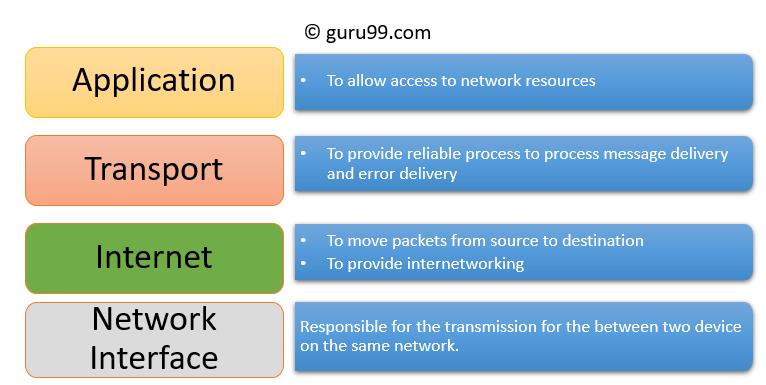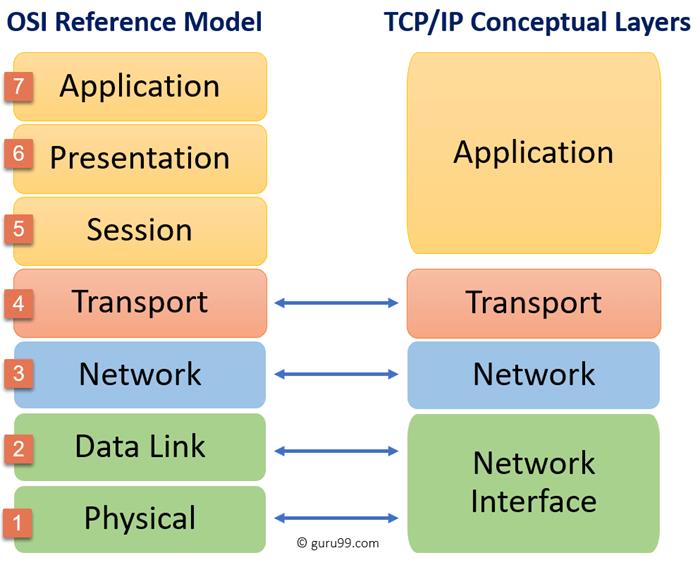TCP/IP Model: Layers & Protocol | What is TCP IP Stack?
Posted rtoax
tags:
篇首语:本文由小常识网(cha138.com)小编为大家整理,主要介绍了TCP/IP Model: Layers & Protocol | What is TCP IP Stack?相关的知识,希望对你有一定的参考价值。
目录
The function of the Application Layers are:
Important functions of Transport Layers:
Differences between OSI and TCP/IP models
Advantages of the TCP/IP model
Disadvantages of the TCP/IP model
What is the TCP/IP Model?
TCP/IP Model helps you to determine how a specific computer should be connected to the internet and how data should be transmitted between them. It helps you to create a virtual network when multiple computer networks are connected together. The purpose of TCP/IP model is to allow communication over large distances.
TCP/IP stands for Transmission Control Protocol/ Internet Protocol. TCP/IP Protocol Stack is specifically designed as a model to offer highly reliable and end-to-end byte stream over an unreliable internetwork.
In this TCP/IP tutorial, you will learn:
- TCP Characteristics
- Four Layers of TCP/IP model
- Application Layer
- Transport Layer
- Internet Layer
- The Network Interface Layer
- Differences between OSI and TCP/IP models
- Most Common TCP/IP Protocols
- Advantages of the TCP/IP model
- Disadvantages of the TCP/IP model
TCP Characteristics
Here, are the essential characteristics of TCP/IP protocol
- Support for a flexible TCP/IP architecture
- Adding more system to a network is easy.
- In TCP/IP, the network remains intact until the source, and destination machines were functioning properly.
- TCP is a connection-oriented protocol.
- TCP offers reliability and ensures that data which arrives out of sequence should put back into order.
- TCP allows you to implement flow control, so sender never overpowers a receiver with data.
Four Layers of TCP/IP model
In this TCP/IP tutorial, we will learn about different TCP/IP layers and their functions

The functionality of the TCP IP model is divided into four layers, and each includes specific protocols.
TCP/IP is a layered server architecture system in which each layer is defined according to a specific function to perform. All these four TCP/IP layers work collaboratively to transmit the data from one layer to another.
- Application Layer
- Transport Layer
- Internet Layer
- Network Interface

Application Layer
Application layer interacts with an application program, which is the highest level of OSI model. The application layer is the OSI layer, which is closest to the end-user. It means the OSI application layer allows users to interact with other software application.
Application layer interacts with software applications to implement a communicating component. The interpretation of data by the application program is always outside the scope of the OSI model.
Example of the application layer is an application such as file transfer, email, remote login, etc.
The function of the Application Layers are:
- Application-layer helps you to identify communication partners, determining resource availability, and synchronizing communication.
- It allows users to log on to a remote host
- This layer provides various e-mail services
- This application offers distributed database sources and access for global information about various objects and services.
Transport Layer
Transport layer builds on the network layer in order to provide data transport from a process on a source system machine to a process on a destination system. It is hosted using single or multiple networks, and also maintains the quality of service functions.
It determines how much data should be sent where and at what rate. This layer builds on the message which are received from the application layer. It helps ensure that data units are delivered error-free and in sequence.
Transport layer helps you to control the reliability of a link through flow control, error control, and segmentation or de-segmentation.
The transport layer also offers an acknowledgment of the successful data transmission and sends the next data in case no errors occurred. TCP is the best-known example of the transport layer.
Important functions of Transport Layers:
- It divides the message received from the session layer into segments and numbers them to make a sequence.
- Transport layer makes sure that the message is delivered to the correct process on the destination machine.
- It also makes sure that the entire message arrives without any error else it should be retransmitted.
Internet Layer
An internet layer is a second layer of TCP/IP layes of the TCP/IP model. It is also known as a network layer. The main work of this layer is to send the packets from any network, and any computer still they reach the destination irrespective of the route they take.
The Internet layer offers the functional and procedural method for transferring variable length data sequences from one node to another with the help of various networks.
Message delivery at the network layer does not give any guaranteed to be reliable network layer protocol.
Layer-management protocols that belong to the network layer are:
- Routing protocols
- Multicast group management
- Network-layer address assignment.
The Network Interface Layer
Network Interface Layer is this layer of the four-layer TCP/IP model. This layer is also called a network access layer. It helps you to defines details of how data should be sent using the network.
It also includes how bits should optically be signaled by hardware devices which directly interfaces with a network medium, like coaxial, optical, coaxial, fiber, or twisted-pair cables.
A network layer is a combination of the data line and defined in the article of OSI reference model. This layer defines how the data should be sent physically through the network. This layer is responsible for the transmission of the data between two devices on the same network.
Differences between OSI and TCP/IP models

Here, are some important differences between the OSI and TCP/IP model:
| OSI Model | TCP/IP model |
| It is developed by ISO (International Standard Organization) | It is developed by ARPANET (Advanced Research Project Agency Network). |
| OSI model provides a clear distinction between interfaces, services, and protocols. | TCP/IP doesn't have any clear distinguishing points between services, interfaces, and protocols. |
| OSI refers to Open Systems Interconnection. | TCP refers to Transmission Control Protocol. |
| OSI uses the network layer to define routing standards and protocols. | TCP/IP uses only the Internet layer. |
| OSI follows a vertical approach. | TCP/IP follows a horizontal approach. |
| OSI model use two separate layers physical and data link to define the functionality of the bottom layers. | TCP/IP uses only one layer (link). |
| OSI layers have seven layers. | TCP/IP has four layers. |
| OSI model, the transport layer is only connection-oriented. | A layer of the TCP/IP model is both connection-oriented and connectionless. |
| In the OSI model, the data link layer and physical are separate layers. | In TCP, physical and data link are both combined as a single host-to-network layer. |
| Session and presentation layers are not a part of the TCP model. | There is no session and presentation layer in TCP model. |
| It is defined after the advent of the Internet. | It is defined before the advent of the internet. |
| The minimum size of the OSI header is 5 bytes. | Minimum header size is 20 bytes. |
Most Common TCP/IP Protocols
Some widely used most common TCP/IP protocol are:
TCP:
Transmission Control Protocol is an internet protocol suite which breaks up the message into TCP Segments and reassembling them at the receiving side.
IP:
An Internet Protocol address that is also known as an IP address is a numerical label. It is assigned to each device that is connected to a computer network which uses the IP for communication. Its routing function allows internetworking and essentially establishes the Internet. Combination of IP with a TCP allows developing a virtual connection between a destination and a source.
HTTP:
The Hypertext Transfer Protocol is a foundation of the World Wide Web. It is used for transferring webpages and other such resources from the HTTP server or web server to the web client or the HTTP client. Whenever you use a web browser like Google Chrome or Firefox, you are using a web client. It helps HTTP to transfer web pages that you request from the remote servers.
SMTP:
SMTP stands for Simple mail transfer protocol. This protocol supports the e-mail is known as a simple mail transfer protocol. This protocol helps you to send the data to another e-mail address.
SNMP:
SNMP stands for Simple Network Management Protocol. It is a framework which is used for managing the devices on the internet by using the TCP/IP protocol.
DNS:
DNS stands for Domain Name System. An IP address that is used to identify the connection of a host to the internet uniquely. However, users prefer to use names instead of addresses for that DNS.
TELNET:
TELNET stands for Terminal Network. It establishes the connection between the local and remote computer. It established connection in such a manner that you can simulate your local system at the remote system.
FTP:
FTP stands for File Transfer Protocol. It is a mostly used standard protocol for transmitting the files from one machine to another.
Advantages of the TCP/IP model
Here, are pros/benefits of using the TCP/IP model:
- It helps you to establish/set up a connection between different types of computers.
- It operates independently of the operating system.
- It supports many routing-protocols.
- It enables the internetworking between the organizations.
- TCP/IP model has a highly scalable client-server architecture.
- It can be operated independently.
- Supports a number of routing protocols.
- It can be used to establish a connection between two computers.
Disadvantages of the TCP/IP model
Here, are few drawbacks of using the TCP/IP model:
- TCP/IP is a complicated model to set up and manage.
- The shallow/overhead of TCP/IP is higher-than IPX (Internetwork Packet Exchange).
- In this, model the transport layer does not guarantee delivery of packets.
- Replacing protocol in TCP/IP is not easy.
- It has no clear separation from its services, interfaces, and protocols.
Summary:
- The full form or TCP/IP model explained as Transmission Control Protocol/ Internet Protocol.
- TCP supports flexible architecture
- Four layers of TCP/IP model are 1) Application Layer 2) Transport Layer 3) Internet Layer 4) Network Interface
- Application layer interacts with an application program, which is the highest level of OSI model.
- Internet layer is a second layer of the TCP/IP model. It is also known as a network layer.
- Transport layer builds on the network layer in order to provide data transport from a process on a source system machine to a process on a destination system.
- Network Interface Layer is this layer of the four-layer TCP/IP model. This layer is also called a network access layer.
- OSI model is developed by ISO (International Standard Organization) whereas TCP/IP model is developed by ARPANET (Advanced Research Project Agency Network).
- An Internet Protocol address that is also known as an IP address is a numerical label.
- HTTP is a foundation of the World Wide Web.
- SMTP stands for Simple mail transfer protocol which supports the e-mail is known as a simple mail transfer
- SNMP stands for Simple Network Management Protocol.
- DNS stands for Domain Name System.
- TELNET stands for Terminal Network. It establishes the connection between the local and remote computer
- FTP stands for File Transfer Protocol. It is a mostly used standard protocol for transmitting the files from one machine to another.
- The biggest benefit of TCP/IP model is that it helps you to establish/set up a connection between different types of computers.
- TCP/IP is a complicated model to set up and manage.
以上是关于TCP/IP Model: Layers & Protocol | What is TCP IP Stack?的主要内容,如果未能解决你的问题,请参考以下文章